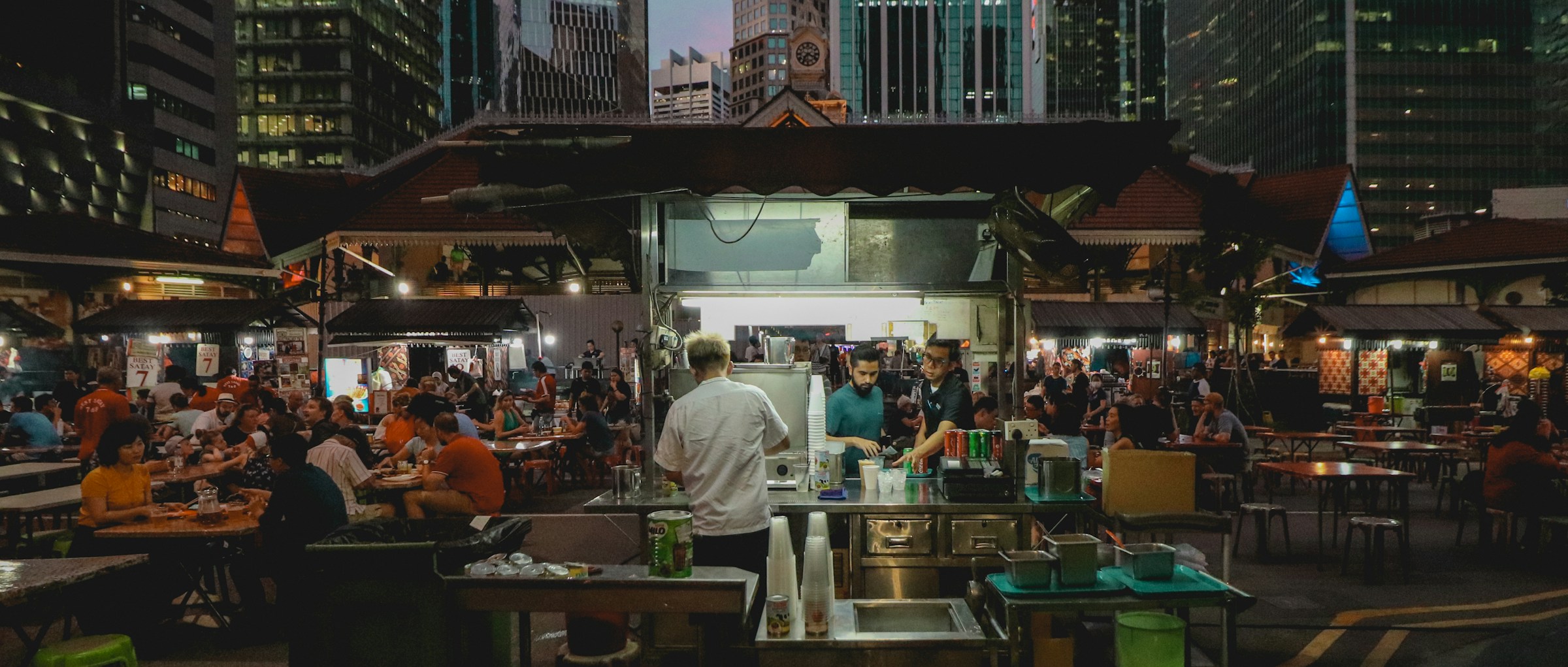While Gulf states pour billions into revitalizing retail districts with climate-controlled markets and community-first zoning, Singapore’s street-level food culture faces a quieter erosion. The closure of a neighborhood zi char stall—once considered unthinkable—is now both symptom and symbol of a deeper strategic misalignment. It’s not about consumer demand or culinary irrelevance. It’s about rental extraction economics winning over ecosystem durability.
This isn’t just a sentimental story about disappearing hawker culture. It’s a structural failure in how retail real estate strategy aligns—or doesn’t—with long-term community vitality. And it’s unfolding not in fringe locations, but in the very kopitiams that anchor daily life.
Zi char stalls, by design, don’t scale. They aren’t optimized for franchising or delivery-first operations. They function through density, repetition, and familiarity: weekday regulars, weekend families, every-table-has-a-favorite-dish kind of cadence. They anchor the foot traffic logic for the entire coffee shop cluster. When one shuts, it doesn’t just affect wok orders—it quietly destabilizes the drink stall, the roti prata guy, the evening beer crowd.
So when five stalls shutter in a single coffeeshop—as one Redditor recently noted—something foundational is breaking. And it’s not about consumer shifts. It’s about price-setting power migrating upward while business risk concentrates downward.
Landlords know the game. As one commenter bluntly put it: “They’ll only lower rent when vacancy hurts.” That logic, while economically coherent, breaks strategically when applied to foundational micro-retail units. Because zi char isn’t just another F&B category—it’s a keystone experience. And once those keystones go, the structure above won’t hold.
What’s shifting here is not just pricing—but the role of real estate actors in shaping business model feasibility. With commission-based incentives and asset flipping normalizing among agents, the food economy becomes collateral to capital velocity. One commenter’s anecdote of a former MNC employee-turned-prolific property flipper isn’t just personal venting—it’s a case study. A low-barrier path to wealth creation is reshaping the incentives: own, mark up, exit. Sustainability? That’s someone else’s problem.
And that problem now includes the auntie who’s been frying fish head curry for two decades—and suddenly can’t afford to stay open.
This isn’t limited to private landlords. Public housing-linked coffee shops, some once built with public-serving intent, are now subject to asset pricing logic that treats food stall rental like a yield-maximizing REIT parcel. Once an HDB kopitiam changes hands at an inflated valuation, the new owner must recoup—and the squeeze lands on stallholders who lack margin, scale, or mobility.
In a Western retail context, this might be framed as creative destruction. But Singapore’s tightly interwoven geography and social infrastructure make that logic unstable. There are no wide suburban belts to “move out to.” There is no untapped surplus of space for displaced vendors. Every closure tightens the ecosystem, and every stall lost shrinks the opportunity map for younger hawkers or neighborhood renewal.
And unlike mall chains that can hedge with e-commerce or outlet diversification, coffee shop stalls are single-node operations. When the rent spikes, they can’t pass it on, scale it out, or defer it. They just exit.
This isn’t a margin problem. It’s a misalignment of risk and reward across the retail supply chain. Landowners get security and passive income. Agents get commissions. Stallholders get none of those hedges—only exposure to footfall variance and cost creep. In a sustainable model, the party absorbing the most volatility should have the most leverage. In Singapore’s food retail layer, the opposite is often true.
The UAE has begun piloting co-op style micro-retail precincts, where rent inflation is capped and zoning encourages communal density. Japan’s shotengai systems deliberately mix ownership structures to prevent extractive cycles and maintain neighborhood vibrancy. In both, there is a strategic understanding that ground-level retail health is not an outcome—it’s an input. Singapore, for all its urban planning sophistication, risks falling behind in that strategic orientation.
Even Hong Kong’s wet markets, long deemed fragile, are seeing slow revival thanks to reinvestment in traditional operators as cultural preservation assets. It’s not charity—it’s ecosystem logic. Anchors keep people coming. Turn those off, and footfall migrates to sterile malls or delivery apps—taking margin and memory with it.
Singapore doesn’t lack F&B innovation. It lacks a framework for local economic sustainability that protects the irreplaceable middle: not hawker centres, not luxury chains, but the zi char-level operators that define community rhythm. What’s being lost isn’t just food—it’s a form of shared space where intergenerational interaction, cost-based trust, and informal anchoring happens.
If that layer fails, what replaces it? More bubble tea kiosks with three-month leases? More dark kitchens optimized for Grab volume? This isn’t about nostalgia. It’s about structural durability. And no ecosystem—especially not one as density-optimized and high-reliability as Singapore—can afford to shed that many anchors without losing resilience.
The zi char rental crisis isn’t a food story. It’s a system failure where short-term real estate logic overrides long-term retail health. And unless landlords, regulators, and retail designers recalibrate the incentive layers, the closures will continue. Slowly. Quietly. Until one day, the wok’s gone cold—and the culture that surrounded it fades with it.
Strategy leaders often champion resilience, yet fail to recognize how extractive rent cycles hollow out precisely the types of operators that build social and commercial stickiness. These aren’t just vendors—they’re rhythm-setters. Their presence stabilizes footfall, sustains adjacent businesses, and keeps informal economies alive. When they exit, what follows is fragmentation: more churn, fewer anchors, and a market more vulnerable to homogenization.
Ignoring this layer isn’t just a misread of culture—it’s a misread of durability. And in high-density cities like Singapore, where proximity is power, strategic resilience depends not on what’s profitable now, but on what’s allowed to endure.















